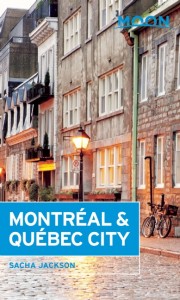
Get ready to walk. The best way to see both cities is by foot (yes, even in the dead of winter). Montréal’s not as sprawling as most North American cities, so it’s fun to wander. In Québec City walking is really the only way to explore. Though it’s hilly, it’s also quite small and dense so you’ll get the most out of your trip—and the best views—if you walk.
Café Figaro in Outremont is a beautiful spot that locals adore. Parc Lafontaine in the Plateau is also a great place to stop for ice skating in winter and picnicking in summer.
Faubourg St-Jean Baptiste just beyond Québec City’s walls, is a great area full of boutiques, restaurants the oldest grocery store in North America. It gives you a taste of life in the city. Also off the beaten track is Parc du Bois-de-coulonge, a beautiful park with amazing views of the St-Lawrence River and lovely gardens to stroll in.
No matter where you’re traveling, it’s always polite to brush up on a few local expressions. Getting simple words down like “bonjour” for hello and good morning and “merci” for thank-you will remind you you’re in a new place. If you want to use this opportunity to brush up on your high-school French, go for it, but if languages aren’t your forte just about everyone you speak to will understand English.
Both cities are quite hot and muggy in the summer, though Québec City is usually a little cooler than Montréal. Come winter (December to March) temperatures are anywhere from -10 to -35C (14F to -31F)
There are great French restaurants throughout both cities, but standouts include L’Express and Lemeac in Montréal and Les Bossus and Clocher Penche in Québec City.
The Olympic Stadium and Buckminster Fuller’s Biosphere, from the 1976 Olympics and Expo 67 respectively, are still some of the most impressive buildings in Montréal. And of course, Québec City’s got 17th-century architecture on lockdown.
Montréal is basically one long festival from May to September. Some of the most well-known are the Montréal International Jazz Festival and Just for Laughs. But I always love Osheaga—three days of outdoor music on an island—at the end of July.
In Québec City it’s got to be Fete d’Ete (Summer festival) and the Carnaval de Québec, (Winter Carnival) a thinly-veiled excuse to party in the winter in snowpants.
If I were to describe it in one word: nonstop. Bars and clubs close at 3 a.m., so it’s not hard to find yourself getting home at the same time the sun’s coming up. There’s also a huge diversity of nightlife: swanky nightclubs, low-key wine bars, classic dive bars and live music of every genre just about every night of the week.
Old Montréal (Vieux Montreal) is a must. There’s a bunch of historic buildings there, but it’s small enough that you can get the most out of it but simply walking around and exploring.
Québec City’s Place Royale is the birthplace of Canada in addition to being really picturesque. It shouldn’t be missed.
Definitely. Montréal has four major universities (college here is more like an extended version of high school), so it’s got a youthful vibe and there are lots to keep young travelers interested, from the local music scene to the free art galleries and even the parks. It’s also a very affordable city, which is great when you’re just starting out.
Montréal’s SAT Foodlab.
I live in Montréal, so I get the chance to indulge in (at least part of) my perfect day a lot. It starts with coffee at Olimpico and a St-Viateur bagel, then a bike ride along the Lachine Canal with a stop on Notre-Dame W. for some antique/vintage rummaging. A trip to Jean-Talon Market for some fresh produce is a must, then it’s over to Alexandraplatz for a drink with friends on the patio. Finally, it’s time for a takeout dinner at Dinette Triple Crown and, of course, a night out at Casa del Popolo.